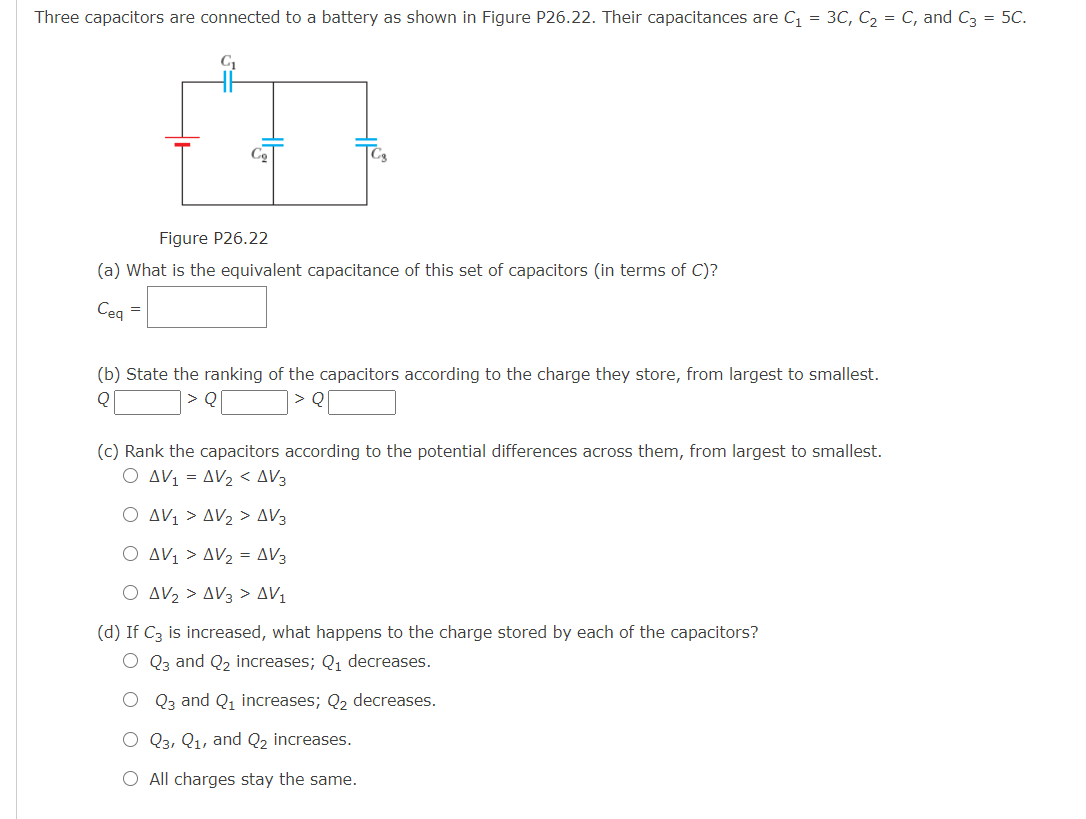Three capacitors are connected to a battery as shown in Figure P26.22. Their capacitances are C = 3C, C2 = C, and C3 = 5C. Figure P26.22 (a) What is the equivalent capacitance of this set of capacitors (in terms of C)? Ceg = (b) State the ranking of the capacitors according to the charge they store, from largest to smallest. > Q > Q (c) Rank the capacitors according to the potential differences across them, from largest to smallest. O AV1 = AV2 < AV3 O aV1 > AV2 > AV3 O AV1 > AV2 = AV3 O AV2 > AV3 > AV1
Three capacitors are connected to a battery as shown in Figure P26.22. Their capacitances are C = 3C, C2 = C, and C3 = 5C. Figure P26.22 (a) What is the equivalent capacitance of this set of capacitors (in terms of C)? Ceg = (b) State the ranking of the capacitors according to the charge they store, from largest to smallest. > Q > Q (c) Rank the capacitors according to the potential differences across them, from largest to smallest. O AV1 = AV2 < AV3 O aV1 > AV2 > AV3 O AV1 > AV2 = AV3 O AV2 > AV3 > AV1
Principles of Physics: A Calculus-Based Text
5th Edition
ISBN:9781133104261
Author:Raymond A. Serway, John W. Jewett
Publisher:Raymond A. Serway, John W. Jewett
Chapter20: Electric Potential And Capacitance
Section: Chapter Questions
Problem 50P: Three capacitors are connected to a battery as shown in Figure P20.50. Their capacitances are C1 =...
Related questions
Question

Transcribed Image Text:Three capacitors are connected to a battery as shown in Figure P26.22. Their capacitances are C, = 3C, C, = C, and C3 = 5C.
Co
Figure P26.22
(a) What is the equivalent capacitance of this set of capacitors (in terms of C)?
Ceg =
(b) State the ranking of the capacitors according to the charge they store, from largest to smallest.
> Q
(c) Rank the capacitors according to the potential differences across them, from largest to smallest.
AV1 = AV2 < AV3
O AV1 > AV2 > AV3
O AV1 > AV2 = AV3
O AV2 > AV3 > AV1
(d) If C3 is increased, what happens to the charge stored by each of the capacitors?
Q3 and Q2 increases; Q, decreases.
O Q3 and Q1 increases; Q2 decreases.
O Q3, Q1, and Q2 increases.
O All charges stay the same.
Expert Solution
This question has been solved!
Explore an expertly crafted, step-by-step solution for a thorough understanding of key concepts.
This is a popular solution!
Trending now
This is a popular solution!
Step by step
Solved in 3 steps

Knowledge Booster
Learn more about
Need a deep-dive on the concept behind this application? Look no further. Learn more about this topic, physics and related others by exploring similar questions and additional content below.Recommended textbooks for you

Principles of Physics: A Calculus-Based Text
Physics
ISBN:
9781133104261
Author:
Raymond A. Serway, John W. Jewett
Publisher:
Cengage Learning

College Physics
Physics
ISBN:
9781285737027
Author:
Raymond A. Serway, Chris Vuille
Publisher:
Cengage Learning

Physics for Scientists and Engineers: Foundations…
Physics
ISBN:
9781133939146
Author:
Katz, Debora M.
Publisher:
Cengage Learning

Principles of Physics: A Calculus-Based Text
Physics
ISBN:
9781133104261
Author:
Raymond A. Serway, John W. Jewett
Publisher:
Cengage Learning

College Physics
Physics
ISBN:
9781285737027
Author:
Raymond A. Serway, Chris Vuille
Publisher:
Cengage Learning

Physics for Scientists and Engineers: Foundations…
Physics
ISBN:
9781133939146
Author:
Katz, Debora M.
Publisher:
Cengage Learning

Physics for Scientists and Engineers, Technology …
Physics
ISBN:
9781305116399
Author:
Raymond A. Serway, John W. Jewett
Publisher:
Cengage Learning

Physics for Scientists and Engineers with Modern …
Physics
ISBN:
9781337553292
Author:
Raymond A. Serway, John W. Jewett
Publisher:
Cengage Learning

College Physics
Physics
ISBN:
9781305952300
Author:
Raymond A. Serway, Chris Vuille
Publisher:
Cengage Learning